Raising Water Consciousness through
World’s Biggest Photo Exhibition and
Largest collection of Photo Stories on Water
Photo Stories | Drinking Water
Integrated Solution for Rural Drinking Water Challenges
Nandita Singh and Om Prakash Singh
16 July, 2017
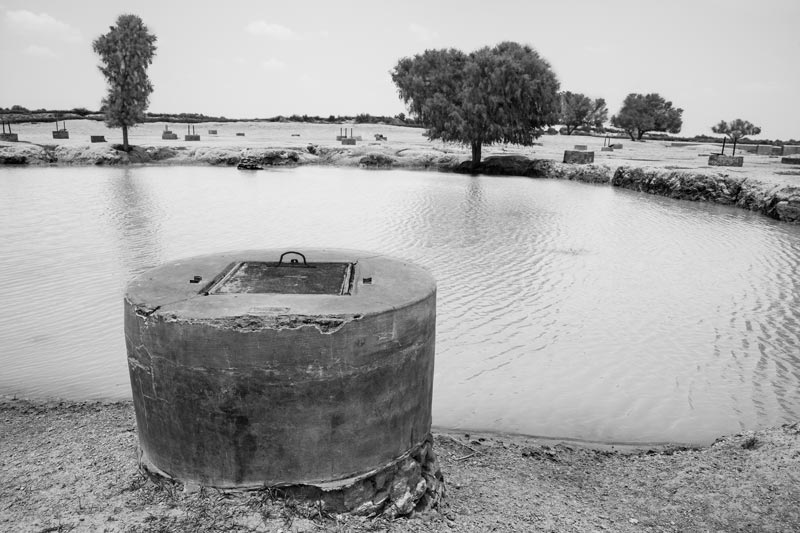
Rural communities in India face multiple challenges in accessing drinking water on the quantity as well as quality fronts, which are assuming serious dimensions in recent times, as presented in the photo story dated 16 June 2017. The government has been engaged in addressing these challenges since long, but several gaps persist, as enumerated in the photo story dated 30 June 2017. With a view to upgrade the rural water delivery service level and to ensure drinking water security in rural India on quantity and quality fronts, Government of India has adopted a Strategic Plan for the period 2011-2022. Within the scope of this Plan, the target of ensuring coverage of at least 90% rural households with piped water supply at home by 2022 has been set, and a number of States are already implementing centralized multi-village schemes supplying piped water from distant surface water sources. For reaching these goals, there is emphasis on decentralized governance, participatory planning and implementation of village water supply schemes, water quality management and sustainable service delivery. However, as seen from the Ghogha project in Gujarat, decentralized governance and participatory planning and decision-making make little sense in case of centralized large piped water schemes because an external water source implies reduced control of local communities over it, with decisions about water allocation, or timing, quantum and frequency of the supply being externally determined. Moreover, these big schemes tend to present more complex operation and maintenance (O&M) problems. All this finally lead to inadequate quantity or even lack of water delivery in the tail-end habitations. In addition, as seen from the Maujampur scheme in Bihar, damage to distant pipelines and poor O&M can undermine the quality of the supplied water in physical, chemical and biological terms. In order to provide rural women, men and children continued access to adequate and safe drinking water, rural water supply systems need to be sustainable, and this in turn requires a sustained ‘bottom-up’ approach where the supply options are rooted in local water resources, in turn responsive to local geographic and ecological context and pressures, traditional knowledge and technologies are incorporated, and the community is realistically engaged from planning through implementation to monitoring. Against this background, this photo story aims to delineate an integrated approach that can help encounter the different challenges on quantity and quality fronts in a comprehensive and sustainable manner, thereby enabling rural women, men and children to enjoy their human right to water and other concomitant rights. The title photo depicts a shallow well (locally called kuiyan) being recharged by an adjacent pond that attains water through drainage from the local village catchment in Bikaner district, Rajasthan.
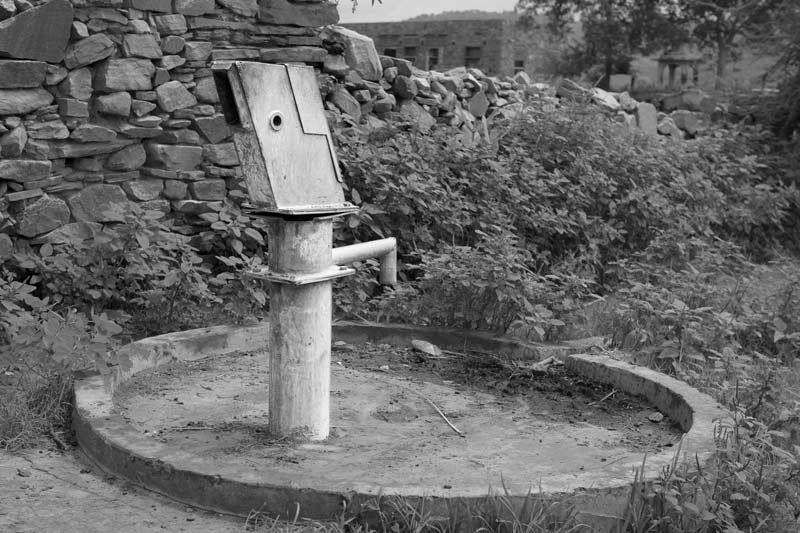
A broken handpump due to inefficient operation and maintenance in Alwar district, Rajasthan
Lack of proper O&M of water supply infrastructures has been identified as one of the foremost causes underlying ‘slipping back’ of ‘covered’ rural habitations in India. Breakdown of sources due to wear and tear of the parts with use is normal, but this should not make water sources inoperational in the long run. Where community drinking water sources are the only option available, prolonged run down time may ultimately lead to perpetually non-functional infrastructures forcing rural women, children and even men to travel long distances and even procure water that is unsafe. There is need to implement effective measures to ensure prompt repair and servicing of rural water supply infrastructures, and this can be organized through capacity-building of the users and their effective participation in managing their own drinking water sources, or through a more accountable service delivery network when O&M is handled by the agency directly.
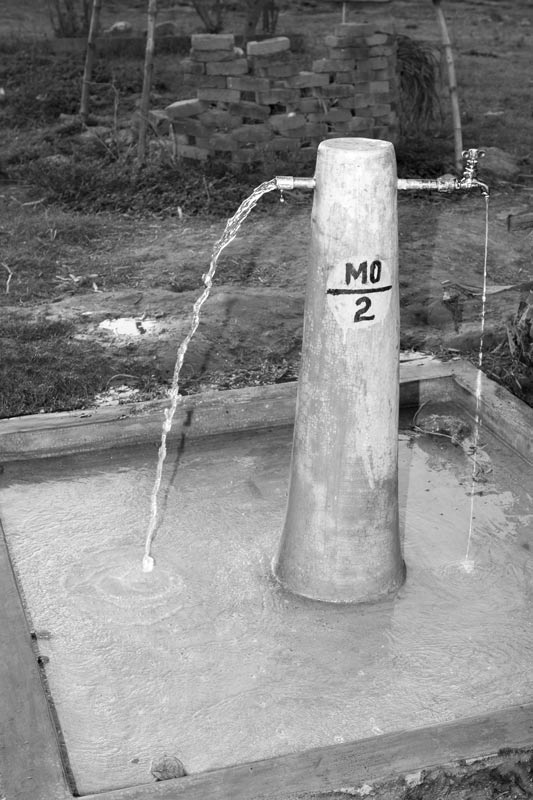
An ill-maintained public standpoint where the missing tap has not been replaced leading to wastage of safe drinking water in an arsenic-affected village in district Bhojpur, Bihar
Inadequate O&M and non-functional infrastructure is also a widespread problem with piped water schemes. In Bhojpur district of Bihar, the multi-village piped water scheme supplying treated Ganges water for 39 arsenic-affected villages is maintained by the government without any community participation, but its service through field-level staff is poor. As a consequence, a number of public tapstands do not possess taps or the pipelines remain damaged for several days which reduces the pressure in pipes, causes massive water loss, and even deproves the water quality delivered. As a result, tail-end villages are often forced to suffer without access to safe drinking water. For ensuring safe drinking water delivery through piped water schemes, it is essential to ensure prompt service and improve O&M, for which availability of adequate funds as well necessary technical inputs and trained manpower is in turn essential.
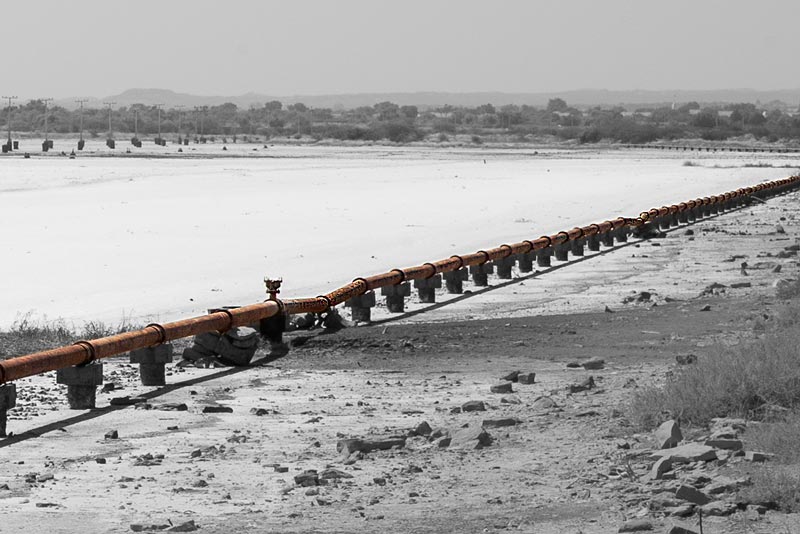
An old dilapidated piped water supply line conveying freshwater across salty stretches in Kutch district, Gujarat
Large centralized multi-village piped water schemes are a seemingly attractive option for supplying water in water scarce as well as quality affected habitations. However, if the maintenance of pipelines and other infrastructures remains neglected, water may get supplied through rusted, damaged and worn out structures which not only may reduce the quantity delivered, but even the quality of the supplied water may get compromised. The old pipeline shown in this photo was laid down with the purpose of providing safe and sweet surface water to rural communities living in an area where groundwater table is very low, and affected by high salinity and fluoride. However, the state of the pipeline raises serious doubts about the quantity and quality of the water delivered because not only is it rusted but also damaged at places causing massive leakage. Given these perpetual problems with long distance piped water schemes, a more sustainable option is to implement schemes based on local water resources. The need is to identify and incorporate sustainable practices for upkeep of the quantity and improvement of the quality of the local resources.
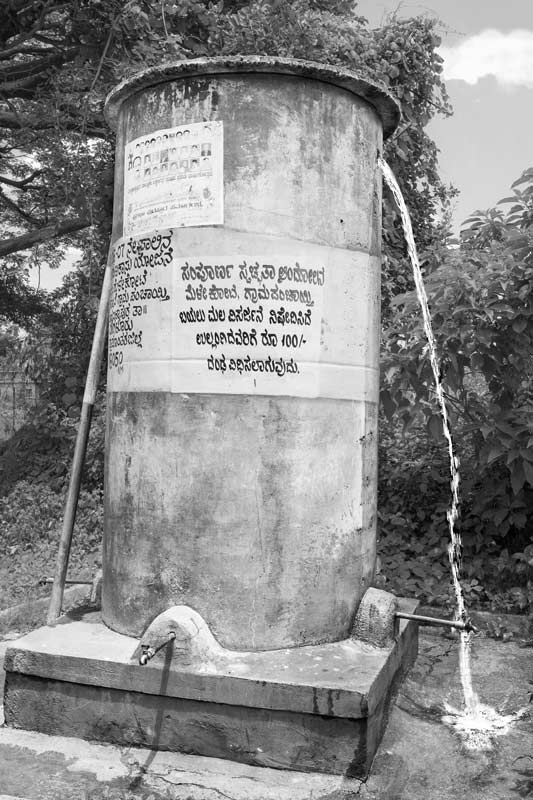
Groundwater being wasted due to poor maintenance of a water tank in Chikaballapur district, Karnataka
Wastage of water is a significant concern in piped water schemes. According to global estimates, up to 50% water is lost in the process of water distribution in the developing and under-developed world. Though no estimates appear to exist for India, wastage of such magnitude breeds water unsustainability and even inequitable access, because not only is the lost quantum wasted unused, but in larger schemes may leave tail-end receivers without water. Wastage and loss of water can occur due to faulty storage structures or damages in supply networks. In the tank shown above, absence of an overflow-control mechanism allows it to be over-filled with the excess water draining out as long as the source tubewell runs. This ultimately leads to over-withdrawal of groundwater in a context where no measures have been adopted to ensure sufficient aquifer recharge. There is need to regularly monitor and repair leakages and check water wastage in piped rural water schemes so that supply efficiency as well as source sustainability can be enhanced, in turn promoting equitable and adequate water access.
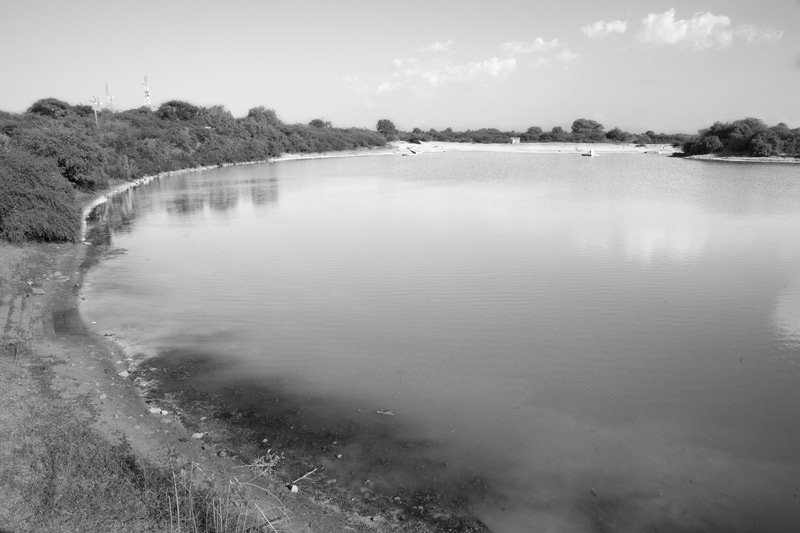
A village pond which helps supply of sweet and safe drinking water through groundwater recharge in a salinity- and fluoride-affected area in Kutch district, Gujarat
Over-abstraction of groundwater for agricultural, industrial and domestic uses without adequate recharge is leading to groundwater depletion. In fact, groundwater withdrawal in India stands at a staggering 250 billion cubic meters/year (bcm/yr), larger than the volume extracted by the United States and China combined. As a result, several areas in the country have come to be identified as ‘over-exploited’, ‘critical’ or ‘semi-critical’ with regard to groundwater depletion. Groundwater depletion causes handpumps, tubewells and groundwater-based piped water schemes go dry, especially in the summer season. Depleting water table also brings quality degradation of the water due to increasing concentration of contaminants. Given this scenario, there is an urgent need to undertake large-scale groundwater recharge in the country. Village ponds and tanks that store rainwater from the local catchment act as percolation tanks, promoting recharge of groundwater in the area. Many rural communities in arid/semi-arid and salinity-affected areas are already traditionally experienced in this practice but after the coming of piped water and other rural water supply schemes many of these structures have been neglected. For ensuring sustainability of handpumps, wells and groundwater-based piped water schemes throughout the year, there is need to support the rejuvenation of existing village ponds and tanks, and construction of new ones, so that groundwater recharge can be promoted.
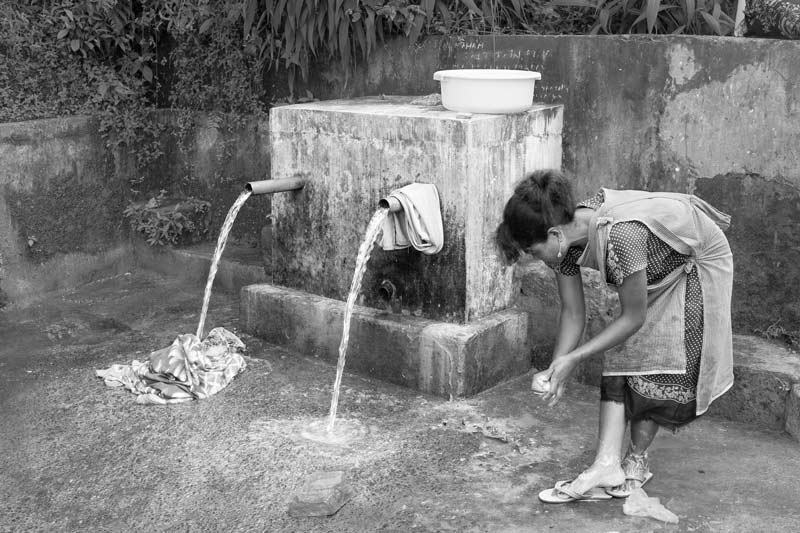
Spring water running through supply pipes during monsoon season in East Khasi Hill district, Meghalaya
In the hills and mountains, despite the impact of climate change, there is plenty of precipitation. As a result, during and immediately after monsoon, the shallow groundwater in the hills and mountains emerges as springs which are directly harnessed for water supply in the local villages. Generally the storage capacity in these spring-based water supply systems is very low, and the water is just allowed to flow, leading to colossal loss of the precious water resources. People living in Sohra village located near famous Cherrapunji town which has held the record of receiving the highest amount of annual rainfall in the world at more than 23,000mm and continues to be one of the world’s highest rainfall areas, today enjoy access to drinking water from spring-fed local water supply system for only 6-7 months. Rest of the year, especially in the dry season, the springs dry up and they have to buy water from tankers that transport water from distant springs and streams. According to one estimate, there are about two to three million perennial springs in the country, which implies a significant water supply potential. There is need to enhance the capacity to store the water emerging from the springs at individual, community or centralized scales, so that drinking water supply needs of local women, men and children can be adequately fulfilled during the lean season.
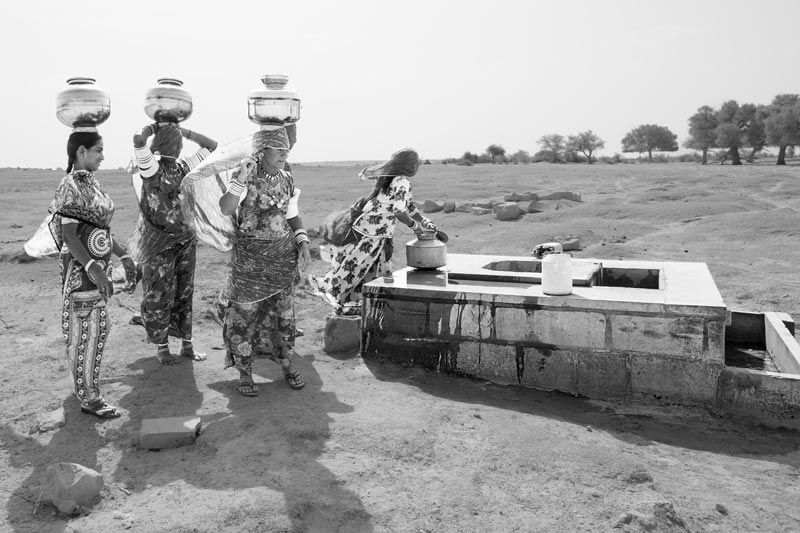
A rejuvenated traditional drinking water well (called ‘beri’) in use in Jaisalmer district, Rajasthan
Traditional drinking water sources in the country have been based on time-tested knowledge of communities rooted in their local ecology, climate, topography, geology and the resultant environmental possibilities. For example, in the arid Thar Desert, where groundwater is generally saline and surface water sources in the form of rivers are almost non-existent, drinking water sources have been designed in such a way that every drop of rain received can be carefully harvested, stored and used. This is done through construction of shallow wells, known as ‘beri’ in Jaisalmer and ‘kuiyan’ in Bikaner districts, within or near catchments that get recharged through rainwater, and supply sweet water round the year. Unfortunately, many of these shallow wells have fallen out of use after the coming of piped water supply which has however proved to be unsustainable. In recent years, realizing their unparalleled value in sustainable delivery of safe drinking water through generations, a good number of these traditional marvels at many places have been rejuvenated. The NGO Sambhaav, under the local leadership of Chattar Singh in Jaisalmer district, has helped rejuvenate 23 ‘beris’ located inside a pond named Viprasar through community participation. This pond is a shared resource of 12 villages and one of these beris is shown above. For sustainable rural water supply, there is need to understand the value of the traditional drinking water sources and instead of replacing them with newer alternatives, revive and incorporate them into the schemes, trying to also scale them up in other areas that share similar hydrological, geological, geographical and climate characteristics.
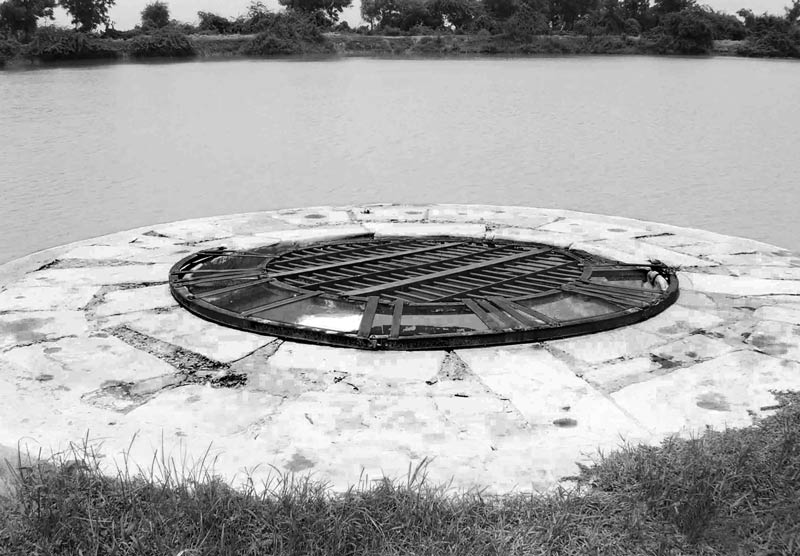
A drinking water well recharged by an adjoining pond in a fluoride-affected village in Patan district, Gujarat
Ponds and tanks can help recharge groundwater in the entire catchment, enabling rise in the water table which can then be abstracted through wells, tubewells and handpumps. In some areas in India, particularly in the arid/semi-arid and salinity-affected areas, there also exists the traditional practice of constructing drinking water wells adjacent to or inside ponds and tanks in the catchment. Such a location helps in two ways: first, the pond water itself may be directly used for drinking and other domestic purposes as long water remains, and second, the wells get recharged with ‘sweet’ water from shallow aquifers. This is common in the Thar Desert in Rajasthan and in semi-arid/arid parts of Gujarat where groundwater is saline and also increasingly reported as fluoride-contaminated. In these areas, rainwater is the major source of freshwater and every drop of it is carefully preserved and utilized through the dual system of tanks/ponds and wells, enabling safe drinking water supply almost throughout the year. Being based on local knowledge and resources, these options are sustainably managed by the community itself. There is need to promote and strengthen such local traditional knowledge and practices for ensuring sustainable rural drinking water supplies, rather than depending upon external alternatives.
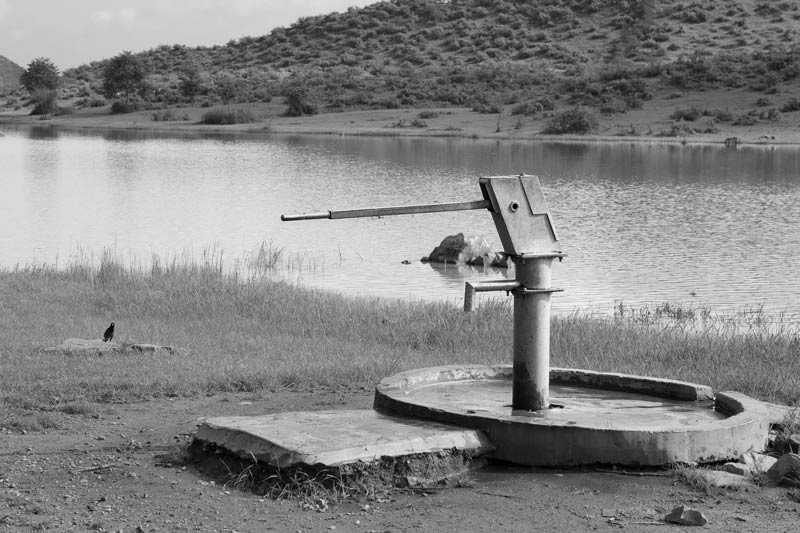
A handpump recharged by the rejuvenated Arwari river in Alwar district, Rajasthan
In Alwar district in Rajasthan, rejuvenation of traditional watershed management / water conservation structures by the non-governmental organization Tarun Bharat Sangh, under the leadership of Rajendra Singh, has led to recharge of aquifers bringing back to life several dried-up wells and handpumps and revival of five rivers, namely, Arvari, Ruparel, Sarsa, Bhagani and Jahajwali. Groundwater in some parts of the district is saline and over 25% of the villages possess groundwater containing fluoride in excess of the permissible limit of 1.5 milligrams/liter. The handpump shown in this photo has been installed on the banks of Arwari river to enable its recharge with shallow sweet water from the river bed and provides safe drinking water to the villagers round the year.
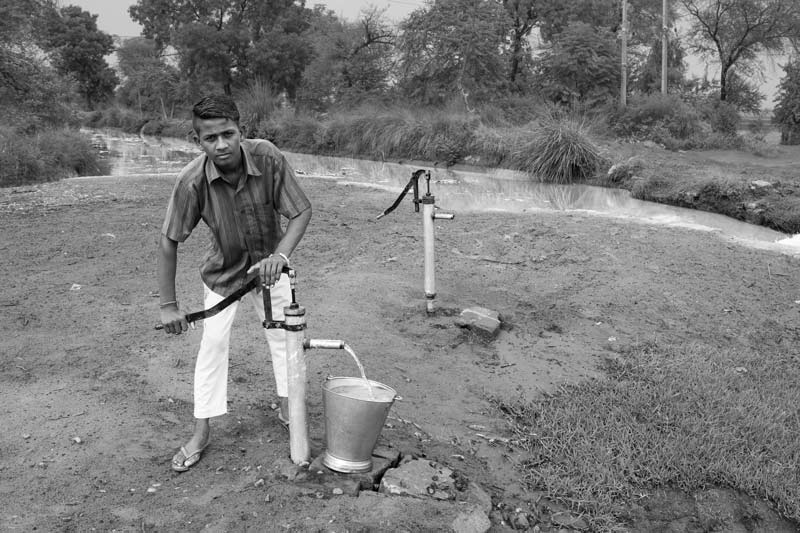
Collecting safe drinking water from a handpump recharged by irrigation canals in Fazilka district, Punjab
Freshwater in the shallow aquifers may also be recharged by water flowing through irrigation canals. In many villages in the southern Malwa region of Punjab groundwater is highly saline and also contains high levels of fluoride, nitrate, persistent organic pollutants (POPs) and several other contaminants. Community water treatment plants installed by the government have failed to deliver safe water to the people due to poor maintenance and technical difficulties. As a local yet sustainable solution, people have installed shallow handpumps in close vicinity of the irrigation canals which supply water almost round the year. Though it implies relative hardship, with villagers needing to carry water loads all the way from the fields to the village settlement, there is large-scale preference for use of this local solution for procuring safe drinking water. From the above three examples in Gujarat, Rajasthan and Punjab, it emerges that wells and handpumps located near ponds, rivers or irrigation canals can help supply safe water in quality-affected habitations through continuous recharge with freshwater from rains or flowing water. Given this tremendous benefit, there is need for the agencies to sustain and promote such local practices in the quality-affected areas.
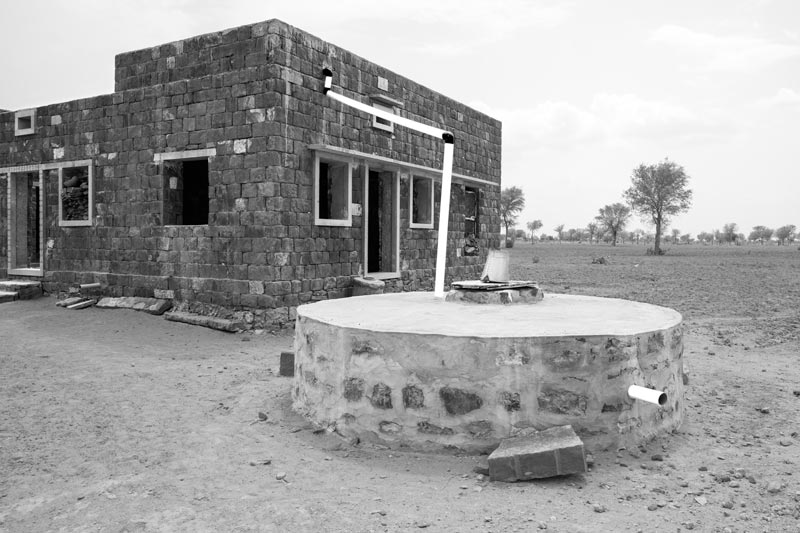
Rooftop rainwater harvesting in Jodhpur district, Rajasthan
A sustainable household-based rainwater conservation alternative is the rooftop rainwater harvesting system where provision is made to collect the rainwater that falls on the roof of the house which is then stored in tanks constructed underground or in external tanks. Since rainwater is the purest form of water, the collected rainwater can be used as potable water if the rainwater collection infrastructure is hygienically cleaned and properly maintained. Depending upon the size of the storage tank, the nature of use and the number of users, rainwater harvested at household level can last a couple of months, thereby augmenting the domestic drinking water reserves. Alternately, the harvested rainwater can be used for artificial recharge of groundwater in the area, which can then be drawn through handpump or tubewell. In the house under construction shown in the photo, the rainwater collected from the rooftop will be combined with that from the surface catchment and stored in an underground tank for household use. In some hill states such as Nagaland and Meghalaya, and arid/semi-arid states such as Rajasthan, Gujarat, Maharashtra and Karnataka, rooftop rainwater harvesting is being increasingly adopted in the rural areas. There is need to upscale this practice all over the country so that dependence on groundwater can be reduced and groundwater recharge be promoted.
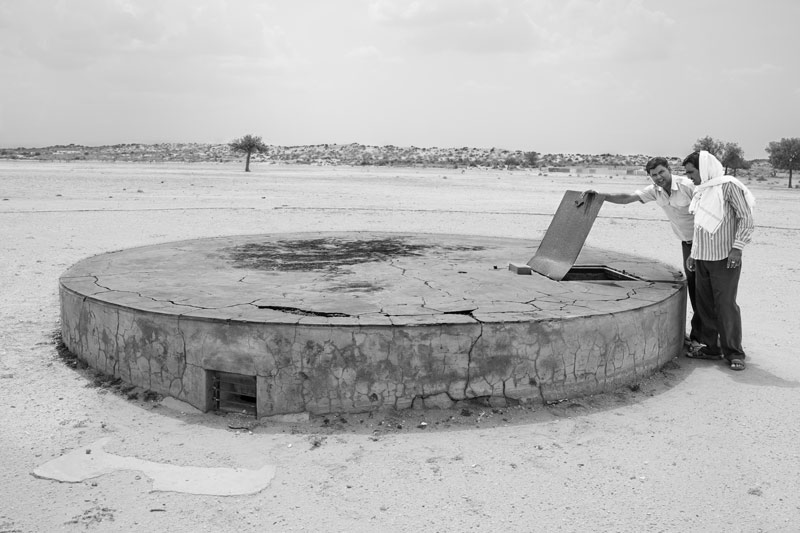
A ‘kund’ for harvesting rainwater flowing from a catchment in Bikaner district, Rajasthan
In a number of water-stressed and salinity-prone areas, traditional practices exist that entail harvesting and conserving the rainwater falling on the ground. In Bikaner district average annual rainfall is only around 278 mm, and the groundwater is largely saline, also containing high levels of fluoride in a few villages, thereby restricting people’s access to sufficient and safe drinking water. As response to these challenges, ‘kund’ is a commonly used rainwater harvesting alternative which consists of a saucer-shaped catchment with a gentle slope towards the centre where an underground tank is situated. The catchment is cleaned and plastered with lime before the arrival of monsoon every year. Kunds may be of 1000 liters capacity or more and often constructed in open areas with large catchments while smaller sized ‘kundis’ are similarly constructed at home. In Jaisalmer district, kunds and kundis are called ‘tanka’. Kund/kundi/tanka is a sustainable technology that should also be promoted and supported in other arid/semi-arid rural areas that suffer from water shortage, salinity or other quality-related problems. It can even be promoted as a sustainable safe drinking water option in quality-affected areas having sufficient rainfall such as in Bihar and West Bengal. In fact, wherever rural houses lack appropriate roof structures to enable rooftop rainwater harvesting but have sufficient space available on the ground, rainwater harvesting from the surface catchment with storage in similar underground structures should be promoted as a practical alternative.
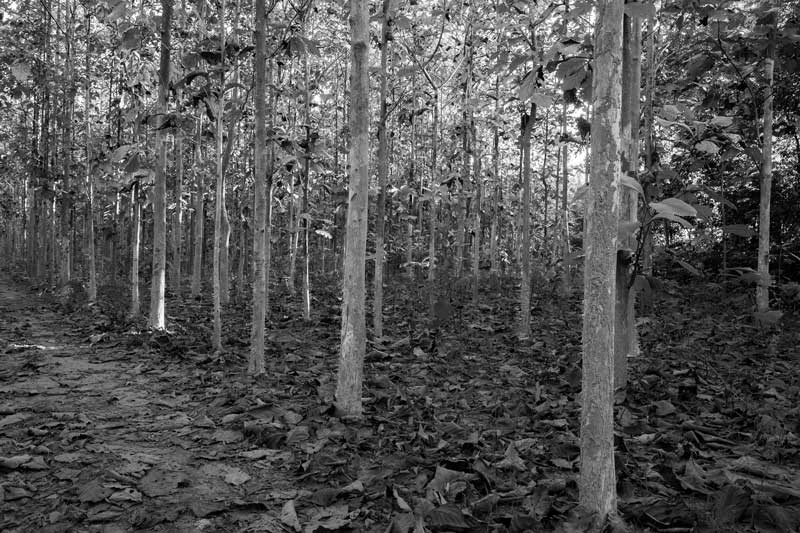
Afforestation in Dimapur district, Nagaland
Extensive deforestation in the country for industrial and agricultural development and expansion of human settlements in the hills, plateaus and plains has reduced soil moisture and hence groundwater recharge, in turn leading to drying up of hill springs, handpumps and wells and even disappearance up of many local rainfed rivers and streams that used to help augment drinking water supply in villages. Adoption of intensive afforestation across all kinds of topographies and ecosystems ranging from hills through plateaus to plains, and from arid/semi-arid zones to tropical/sub-tropical climates, is a good solution which can help catch upto 65% of the precipitation received as ‘green’ water in soil. A part of the green water ultimately percolates down to the aquifers to recharge the ‘blue’ groundwater reserves, which in turn can help rejuvenate and recharge springs, streams, wells and handpumps. Wherever forests have been removed, reforestation should be attempted and maximum efforts should be made in general to restore the green cover wherever lost. For maximum benefit, care should be taken to re-plant varieties that are part of the natural vegetation of the area.
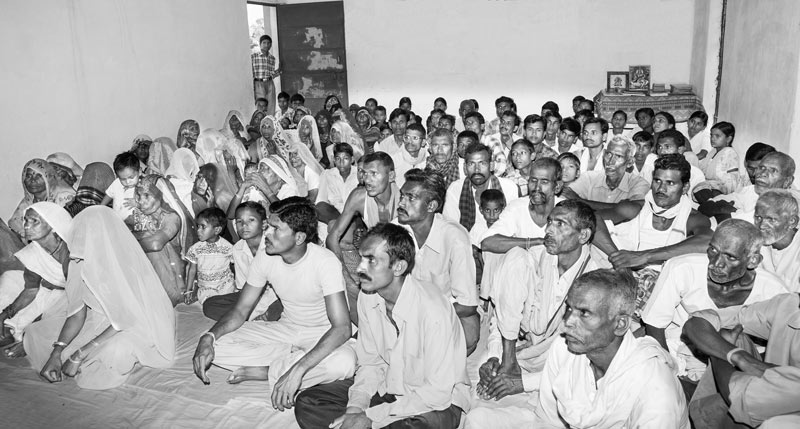
Enhancing sustainability of rural drinking water supply system through community participation in district Morena, Madhya Pradesh
Drinking water is everybody’s business in a community and therefore sustainable rural drinking water supply need to be rooted in effective community participation. Previous photos have depicted varied situations where rural water supply systems have become defunct or non-functional due to lack of true community involvement. Though women are often the primary domestic water managers, not only is their participation necessary, but there is need to involve both the genders equitably because both may possess gender-specific knowledge about the local water resources and issues and share different kinds of responsibilities with regard to their upkeep and use. Further, they may hold different kinds of potentials to contribute in the process. What is important is active and effective community involvement, for which there is need to foster a true ‘bottom-up’ approach where community’s traditional knowledge and practices are taken as the starting template, to be further enriched through external inputs. A number of NGO initiatives in the field have exhibited the scope and importance of realistic community participation. The government initiatives have several lessons to learn from there.
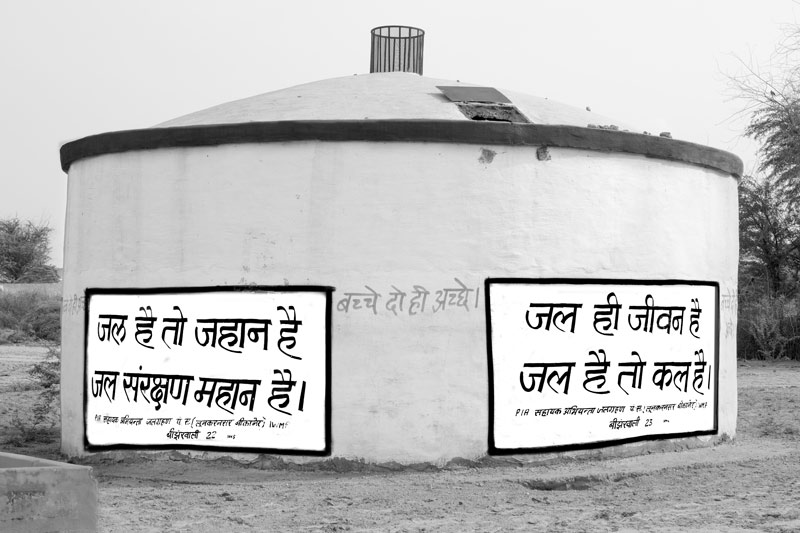
IEC messages, describing the indispensability of water, written on the walls of a storage tank in a rural water supply scheme in district Bikaner, Rajasthan
Elaborate campaigns for information, education and communication (IEC) are essential for actively engaging rural communities in the efforts for sustainably tackling the rural drinking water challenges. Different community members may be at different levels of the knowledge and sensitization continuum regarding the problems and prospects confronting the sector. Appropriately worded messages in the local language that match the local context, needs and the user aspirations must be widely publicized, so that the local stakeholders can be adequately sensitized and motivated for effective and sustained action. The left message shown in the photo above expresses “if there is water, world would survive; water conservation is great!” and the second one says “water is life; if there is water, tomorrow is there!”
The components of an integrated approach for ensuring a sustainable rural water supply have been enumerated above. It is amply clear that in order to be sustainable, the water supply system must be based on local water resources, whether surface or groundwater, which can be protected, augmented, controlled and utilized more sustainably through true ‘bottom-up’ community participation. According to the Ministry of Water Resources, the average annual run off available in the country is 1,840 bcm, out of which only 157.8 bcm can be stored in the dams and reservoirs across the country. If the lofty goal of supplying >9 million rural population with piped water supply preferably from distant surface water sources is to be fulfilled, the annual water requirement would be 21.3 bcm at the planned supply level of 70 liters per capita per day, which would amount to ~13% of the storage above. However, actual storage over last decade has been much lower, and given the fierce competition over the use of this limited resource from other sectors, notably irrigation, urban water supply and industries, implementation of large centralized rural piped water schemes could end up as mere infrastructure constructions with little or no water at least for a major part of the year. Further, given the degrading groundwater quality, and the inefficiency and limitations of the available water treatment technologies, there is also need to look for long-term integrated solutions which can address the quantity and quality challenges together. Against this background, coupled with the climate change projection whereby glacial rivers of the north, particularly the Ganges, are feared to be reduced to rainfed ones by 2050, a total replacement of the form of rural water supply in the name of service-level upgradation, demand management or users’ choice is not a wise and sustainable option. It could lead to wasteful expenditures without achieving real sustainability. Instead, the same financial resources can be more effectively utilized for better O&M of existing structures, conserving and augmenting local water resources, and developing rural water supply systems rooted in these resources through simple technologies that communities can sustainably use and manage. There should be emphasis on ‘catching the rain where it falls’ and impounding the runoff at the local scale, integrating the traditional knowledge and wise local water management practices. The traditional drinking water sources, which were largely dependent on rainwater, need to be identified, rejuvenated and integrated into the design and implementation of rural water supply schemes. This is possible through realistic participation of local communities in planning, implementation, management and monitoring of their drinking water supply systems at village scale which is essential for their sustainability. The water supply system operational in village Ralegan Siddhi in Ahmadnagar district, Maharashtra developed under the leadership of Anna Hazare, is an excellent example of this approach where piped water supply based on groundwater is ensured round the year through an efficient rainwater harvesting system enabled through community participation. Finally, a sustained IEC campaign that reinforces important values regarding water sustainability such as water conservation, judicious use and reuse of water should be adopted. In a context where rural communities are faced with serious challenges to accessing sufficient and safe water, if the ultimate goal is to enable India’s rural women, men and children to sustainably enjoy their human rights to water, health, education, culture and overall development, then instead of short-term lofty solutions, there is need to implement truly decentralized, community-based solutions that are rooted as described above.